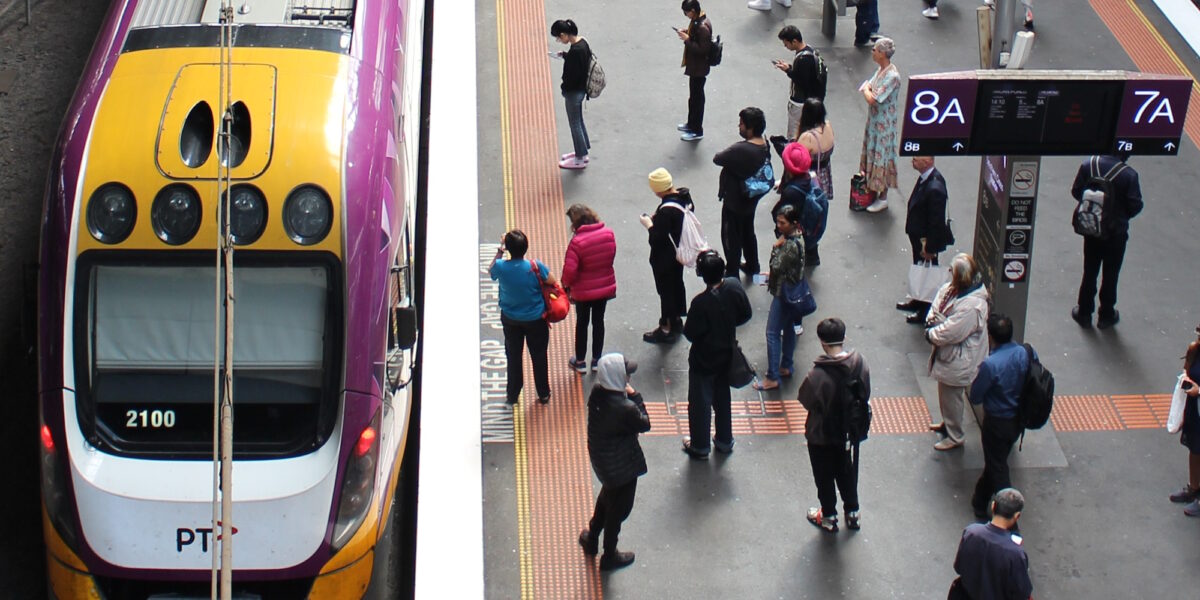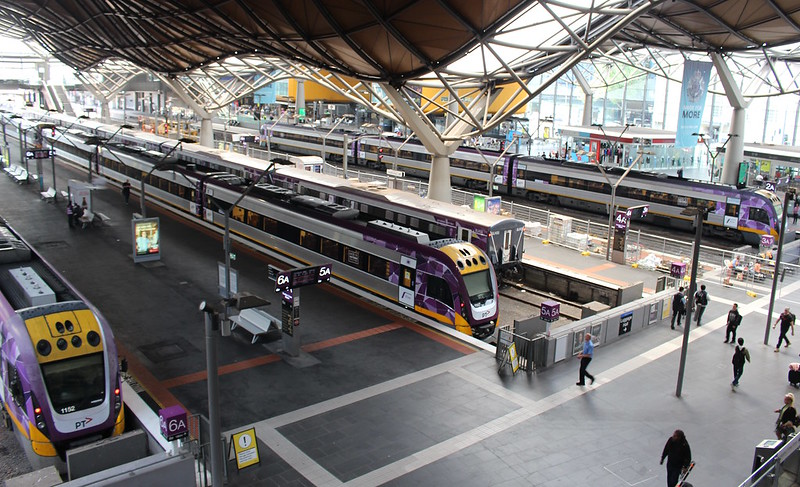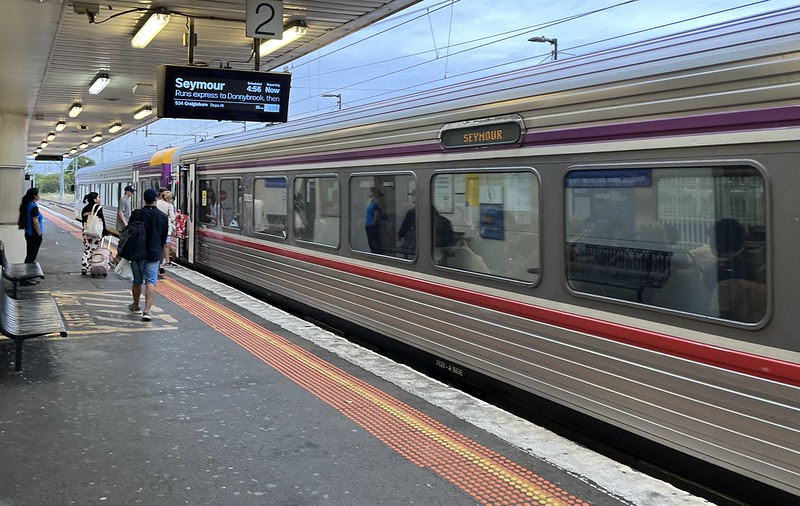A big V/Line fare cut is coming up next week, and it may see a rapid surge in passengers.
Labor promised the change during the 2022 election, and it starts on 31st of March. The cap will be:
- $9.20/day (adult, weekdays)
- $6.70/day (adult, weekends and public holidays)
- Half that amount for concession
- For Passes, the same as Zone 1+2 Myki Passes
This is slightly different from metropolitan Myki fares in that it’s a daily cap, not a $4.60 one way fare maximum.
In other words, the maximum one way fare will be $9.20 – though there are some exceptions for services running outside Victoria to places like Canberra. In those cases, you’ll pay more if travelling more than 60km outside Victoria.
How much is the discount?
In one of the most expensive cases, the $46 Swan Hill to Melbourne fare will be $9.20 one way, a cut of 80%.
If you decided to come back the same day (perhaps unlikely given it’s a 4.5 hour trip each way, and there aren’t many services) then you’d pay no extra – a total of $9.20 for what currently costs $92, or a 90% cut.
A more common trip might be Geelong to Melbourne return. This is currently $27.60 return in peak. It’ll drop to $9.20 return, or 67% cheaper.
An off-peak return is currently $19.32. On a weekday it’ll be $9.20 (52% cheaper). On a weekend it’ll be $6.70 (65% cheaper).
The fare cut seems to put paid to the idea that the ticketing system needs complex rules to track hundreds of zone combinations.
And – apart from weekends being cheaper than weekdays – the change also ends the distinction between V/Line’s peak and off-peak fares.
Peak and off-peak was part of managing demand. Peak usage is still down on 2019 levels – against off-peak being more-or-less back to “normal”. So perhaps it isn’t important anymore. Which brings me to…
Crowding?
The obvious question is: if the fares get much cheaper, how many more people will travel?
Given the higher cost of peak at present, it may prompt more people to travel at peak times when services are more frequent/convenient. Right now the system can probably cope with some extra peak passengers, given numbers are still down compared to pre-COVID. (As on other modes, Mondays and Friday patronage is still lower than Tuesday to Thursday.)
I suspect though that the patronage increase will be higher at other times, as recreational/discretionary travel grows. Interpeak, evening and weekend travel might increase the most. And patronage at those times is mostly back at pre-COVID levels.
Are more services planned?
The good news is that if most of the increased demand is outside peak times, there’s plenty of carriages and track capacity to run more and longer trains… at least in theory. But will they run more services?
Some. Another part of Labor’s election pledges was more services on the Geelong and Ballarat lines. But these aren’t expected to start until next year.
It’s worth noting that carriages aren’t necessarily available while they’re not in service. I’m told a lot of carriages are in maintenance on the weekends – meaning more investment in maintenance capability is needed from government.
I’m not sure the same is true between the peaks on weekdays, given the number of trains often parked at Southern Cross during the day.
What can V/Line do?
From chatting to V/Line management, they are only too aware of the fare cut’s potential impact on their services.
They’ll be trying to ensure that all their services run as planned, including the number of carriages as scheduled.
The VLocity fleet normally runs as 3 or 6 cars. When a 6 car set is scheduled, but only 3 turn up, you predictably get crowding:
(You can see what is meant to run in the Network Service Plan aka Working Timetable.)
Shorter than expected trains are usually due to faults and animal strikes.
But they’ve also got short trains scheduled in the timetable. The Seymour line often has 2-car trains for instance, which are often already full, and unlikely to cope with much growth.
So really they need government investment to improve the availability of carriages – allowing more consistent running of longer, and more services.
Running more services requires more drivers, conductors, fuel and maintenance staff, again meaning government has to provide the funding.
And you can’t wave a magic wand and instantly get fully qualified staff. It all takes time.
2006-07 revisited?
It’s interesting to compare with events 15 years ago on the suburban rail network. At that time, Connex ran a lot of short trains outside peak times.
There was strong 7-day patronage growth around this time, leading to crowding, and the removal of Zone 3 in 2007 and the introduction of the Weekend Saver fare in 2008 helped push that along.
As it turned out, nothing gets funding for rail upgrades like crowding. I get the strong sense that history is about to repeat itself.
Coach services will also be something to watch, with some reports already of strong patronage ahead of the fare cut.
Fare cuts are good, especially given the anomalies in the old fare structure. And more people using public transport is good. But only if the system can cope with it.
If an influx of passengers crowds out some people, and in the medium term puts people off using the service… that’s not so good. It’s a missed opportunity to win those passengers.
Brace yourselves, V/Line users. The next few months may be rocky.
And if you see problems, be sure to snap a photo on your phone and post it on social media, or failing that, send it to me!
- The Age 16/2/2023: V/Line to take you anywhere for $9.20. But will it get you a seat?
- North Central Review 14/3/2023 – focusses on crowding on the Seymour line




18 replies on “V/Line’s permanent doorbuster sale”
Great report – I haven’t read anything that detailed anywhere.
“Fare cuts are good” – does anyone know what the VLine cost recovery ratio is now and what it’s likely to be when fares drop? By that, I mean how much does revenue from fares go towards paying for the system operations.
There is are some extraordinarily good value trips you will be able to take. If you have a spare 17.5 hours and and are willing to undertake four mode changes you can travel all the way from Mallacoota to Mildura for $9.20, less than $0.01 per km.
@roger Not as much as you think. The 2022 V/Line annual report on page 16 https://corporate.vline.com.au/getattachment/cd7ab314-e83b-466a-afe8-d1f3953bd633/Annual-Report-2021-22 reveals it is $42.5 million in 2022. In the scheme of things, that’s not a lot to pay for what will most likely be a popular initiative.
@roger The annual report reveals that annual expenses to operate V/Line are $1.2 billion. Farebox revenue contributes just 3.5% to this amount. Balance this against the increased economic activity this will bring to the regional areas.
A few questions remain unanswered from the expanded info on the PTV website (https://www.ptv.vic.gov.au/more/introducing-fairer-fares-for-regional-victorians/):
– clarity around first class on long-distance lines (have heard reservations are now first-in, first served at no extra price)
– family traveller fares going forward
– partial refunds for anyone with a current myki pass for regional zones
– any changes to incorporate non-myki buses in the daily cap (eg town buses in Shepparton or Warrnambool, Castlemaine – Maldon, Sunbury – Lancefield etc)
– clarification around free weekend travel for seniors/disability pension recipients/carers (I take it this will still be for two adjacent zones, $3.35 return is still amazing value for them)
There is some info here about those with existing Zone 1+2 myki passes and travelling to regional areas from next Friday – https://www.ptv.vic.gov.au/more/introducing-fairer-fares-for-regional-victorians/already-using-a-myki-pass/
While the cuts to fares will be good, they could’ve cut the fares but maintain the zone system by maybe cutting fares by 5 to 10 per cent. That way it is cheaper, but it better reflects the distance travelled by people. If you look at the bigger picture, this might be a sugar hit in the short term, but in the medium and long-term, it will not be sustainable without proper investment in public transport, like more trains, buses and trams. It is not cheaper fares that will attact people to public transport, but it is frequency and quality. I fear that the quality will get worse as a result of these drastic cuts, and much of the fares for public transport goes back into public transport. I think that this is one of those watch this space thing.
There’s an old saying among economists that “there’s no such thing as a free lunch”. I suppose the cost will eventually find its way into the pockets of taxpayers (present or future)…..
I would have preferred it if they had kept a simplified zone structure rather than go to a state-wide flat fare.
Zone 3 – $4.6 one way / $9.2 daily
Zone 4 – $9.2 one way / $18.4 daily
Zone 5 – $13.8 one way / $27.60 daily
Zone 6 – $18.40 one way / $36.80 daily
Zone 7 – $23 one way / $46 daily
Zone 3 – 75km from Melbourne
Bunyip
Broadford
Waurn Ponds
Ballan
Woodend
Zone 4 – 150km from Melbourne
Murchison East
Violet Town
Colac
Beaufort
Maryborough
Elmore
Eaglehawk
Zone 5 – 300km from Melbourne
Bairnsdale
Orbost (Bus)
Shepparton
Albury
Warrnambool
Portland (Bus)
Ararat
Horsham (Bus)
Echuca
Swan Hill
Zone 6 – 500km from Melbourne
Merimbula (Bus)
Canberra (Bus)
Mount Gambier (Bus)
Mildura (Bus)
Zone 7 – more than 500km from Melbourne
Adelaide (Bus)
I think the idea put foward by @Hornberger is an good idea as it is simple and a better solution than the flat fares. It allows cheaper fares while recognising that it costs more to travel further (by keeping the zone system that works at the same time, albit simplifer than the current zone system). Problem though is that many of the destinations further out don’t have Myki, hence it could be more difficult, especially with the coaches (although paper tickets can still be used beyond the commuter belt). Last year, I was in Ararat and there was infrastructure at Ararat Railway Station for Myki (until the Ballieu government got rid of Myki on interurban services beyond the commuter belt, so it was never implemented there).
And for interstate destinations more than 500 kilometres away, we might need a more national system for it to work, which can be a problem due to the largely state-based systems used for ticketing (like Opal in Sydney or GoCard in South East Queensland), and they tend to be incompatible with other systems.
The trains that are parked up at Southern Cross may be available to run extra services but the flip side will be they will run up the kilometres and need servicing sooner than before so there’s only so much extra capacity that can provide.
The way to get investment in infrastructure and improve capacity on regional lines is by increasing patronage. I have commuted from Bendigo to Melbourne for 6 years. This will save me thousands, which I will spend elsewhere! The added bonus for road users is that this will reduce vehicles on the road.
I am pleased we have a govt that actually thinks long term.
How will this be implemented for paper tickets, unless you buy all your tickets for the day at the same time? For Myki the system automatically calculates the daily cap. Or is Myki being rolled out in regional areas as well?
Myki has already been rolled out to commuter services (Waurn Ponds, Wendouree, Raywood, Goornong, Seymour and Tararlgon) and was originally planned to be rolled out on all trains, including interurban services. In fact, as I mentioned in a previous post, there is infrastructure for Myki at Ararat Station, which I saw when I was visiting Ararat last year. However, the Ballieu government decided to stop the rollout of Myki on interurban services and kept Myki on the commuter Vline services to the destinations I mentioned at the beginning of the post (although at the beginning, Myki ended at Eaglehawk and Epsom, but was extended to the new stations like Raywood on the Swan Hill line and Goornong and Huntly on the Echuca line last year).
@Craig PTV told me the following:
—-
The daily fare cap applies to public transport across the state where myki or paper ticketing apply. This includes PTV regional buses, town buses and V/Line trains and coaches. The Albury to Mount Beauty bus is covered under the regional fare cap.
To ensure customers are only paying the $9.20 fare cap, if any of your journey involves travel on a V/Line paper ticketed train or coach service, you should purchase a V/Line paper ticket for your entire journey. e.g. If you’re travelling on the bus from Mount Beauty to Albury then catching a V/Line train to Melbourne, you should purchase a V/Line ticket from Albury to Melbourne and it will cover your bus journey from Mount Beauty.
—-
(Here, I am talking about the regional bus from Albury to Mount Beauty via Dederang, not the V/Line coach+taxi from Wangaratta to Mount Beauty.)
So this suggests that if you buy an appropriate regional ticket that hits the fare cap, and you want to transfer onto a town bus that isn’t myki-ticketed, you can just show the regional ticket to the bus driver? I’ve gotta say, I wouldn’t want to try this without $4.60 backup cash in my back pocket.
Also @Craig is correct about first class. From PTV again:
—-
Seats in the First-Class carriage on long-distance locomotive hauled trains will continue to be available to passengers with reservations on a first come, first served basis. First class will no longer exist as a ticket type and will be the same price as an economy ticket.
—-
Interesting with the abolition of off-peak fares some fares have been reduced outside of the daily cap – e.g. Zones 2-4 used to be $3.78, now $3.60, which is a 4.8% reduction.
While the daily cap removes all the fare anomalies for a return trip, you can still get to Geelong for less than $9.20 one-way if you aren’t returning on the day and you don’t mind breaking the trip – break at Sunshine = $8.20 (Zone 1, then Zones 2-4, save 11%), break at Lara = $7.00 (Zones 1-2, then Zone 4, save 24%), break anywhere in between = $5.10 (Zones 1-2, then Zones 2-4, but minus Zone 2 because you already have it, save 45%).
And you’ll still pay $4 extra (87%) for the privilege of travelling the extra stop outbound beyond Lara on a one-way trip – when the marginal cost of travelling an extra stop outbound beyond all other stations up to Lara is zero.
If your Myki is on auto top-up you might want to check your settings. I had mine set to top-up when my balance fell below $50 so as to cover trips to Bendigo and Ballarat, but now $20 is plenty.
A few points here.
#1, how long will this last? say, a few years before we find we just cant afford the costs. Any Govt in the future can stop this whenever they want. Perhaps they may go up to a higher $15 or $20 cap???
#2, will this help the rollout of MyKi to the whole V/Line train network?
Given, if memory serves me correctly, there was much of a problem when you had too many zones in the network. With the current setup, there is in effect, no zones in the system anymore?
#3, I can travel from Malacoota to Mildura on this cap. I am tempted to do that some time soon. Go Melbourne, Cann River, Mildura, Melbourne. May take three days, but, for less than $30, that is a great deal to me.
#4, I have noticed in respect to Interstate V/Line services, such as, to Canberra and Adelaide, their fares have reduced somewhat too. Not down as low as under $10, but, have reduced to reflect the Victorian section to be no more than for this new cap.
#5, The V/Line Vlocity production rate is at a really bad and slow frequency. I believe that #106 is about to leave the factory. That is much unlike the case with Metro. They are getting a fantastic deal. Perhaps we should let Metro suffer for a while, and divert the good luck to V/Line for a while.
#6, what about the current state debt issue. The state is broke? How is that going to impact any of this?